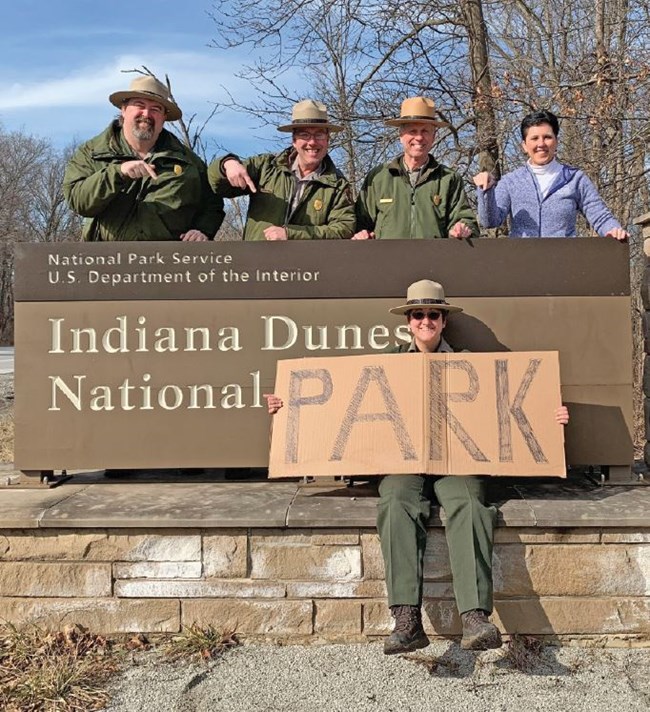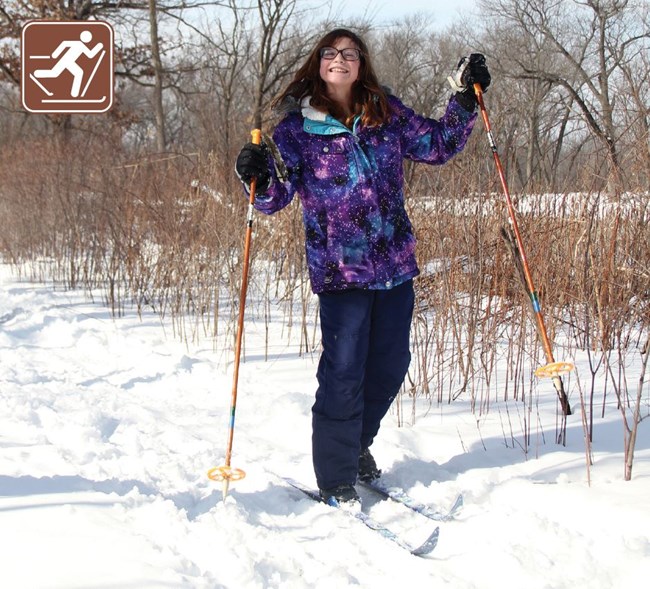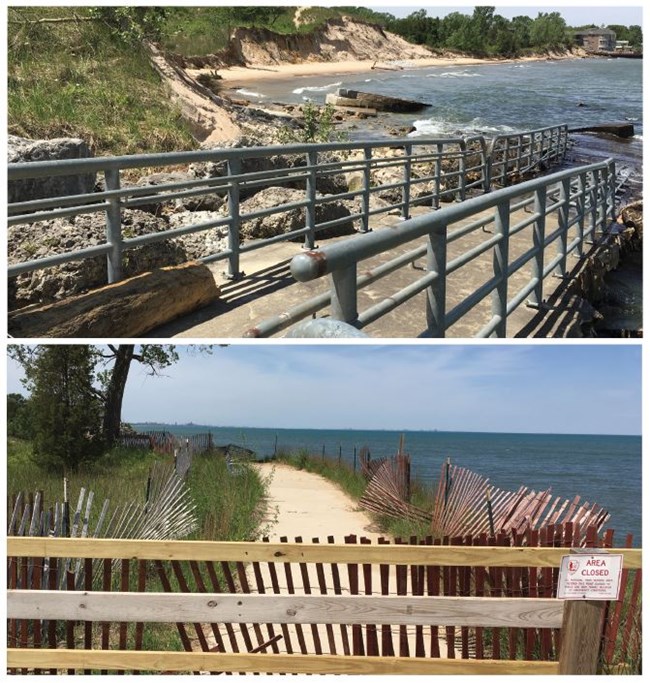
Why the new name and what does it mean?Indiana Dunes National Lakeshore was established on November 5th 1966 and was redesignated a National Park on February 15, 2019, making it the country’s 61st national park. The 53 year old Indiana Dunes National Park includes 15,000 acres of the southern shore of Lake Michigan and surrounds the Indiana Dunes State Park, which manages 2,182 acres, and is owned, managed, and protected by the state of Indiana. The State Park entrance lies at the north end of State Road 49 in Porter County while the National Park’s 22 miles stretch from its eastern boundary near Michigan City, IN and continues west toward Gary, IN. So What has Changed?More visitors! Since its new designation, the park has seen 70 percent more visitors at our main visitor center. In 2018, the Indiana Dunes National Park total visitation at the visitor center alone was 93,502 visitors. As of November 1, 2019, the Visitor Center’s count is 161,552. The Visitor Center has a sign-in kiosk that shows visitation statistics and comments from visitors around the country and the world. This year’s October numbers showed that 46 out of 50 states were represented by signing the book as well as 19 countries. Here is what one of our recent visitors said, “Living in Dublin Ireland, I was listening to Dublin City FM radio station and heard advertisements for Indiana Dunes. This advert grabbed my attention as I was due to visit Chicago and Indiana, so I googled Indiana Dunes and was amazed to see that the Dunes now has National Park status. Needless to say, I immediately added a visit to them to my itinerary, and I was so glad I did. My trip to the USA was very short, only four days, but I was thrilled that I was able to make it to your Visitor Center, and definitely the next time we are all visiting the area again, we will spend more time in Indiana exploring the Dunes.” Visitors are not the only folks who are excited about the name change. “Northwest Indiana has a new feather in its cap, and we all have an opportunity to use the Indiana Dunes to increase our economic development,” said Lorelei Weimer, the executive director of Indiana Dunes Tourism. Why Was the Name Changed?Here are a few reasons behind the re-designation and how it has helped the local communities and state. In 1916, the first Director of the National Park Service, Stephen Mather, wanted to make a Sand Dunes National Park as one of the first national parks. He even held a public forum in Chicago in October of 1916 and presented the question to the audience, to which they replied with a resounding, “Yes!” Unfortunately, in 1917, with the US entering WWI, the cry to “Save the Dunes” was changed to “First Save the Country, then Save the Dunes.” Eventually, the special qualities of the area resulted in the formation of the Indiana Dunes State Park in 1926. It wasn’t until 1952, with the creation of the Save the Dunes by founder Dorothy Buell that a second charge was led, resulting in the establishment of the Indiana Dunes National Lakeshore in 1966. The Indiana Dunes is the 4th most biologically diverse area with regards to flora and fauna, out of all the 419 national park sites. That means our 15,000 acres compares with the millions acres of much larger parks. “The park is one of the most ecologically diverse places in North America,” said park superintendent, Paul Labovitz, noting that it sits at a crossroads where the northern arctic climate meets the southern arid climate. Also, eastern deciduous forest meets prairie at the southern tip of Lake Michigan, which serves as a major bird migration route. The park has a fantastic contrast between heavy industry and natural preservation. As unsightly as some industrial complexes might appear to some, they are very much part of our American story. We grew up as a nation at the same time we were industrializing. The surrounding industry marks another excellent chapter in American progress and forces us to seek a balance between, “Industrialization and Conservation; work or play?” In addition, we are an urban park. There are very few urbanized national parks in the nation. Indiana Dunes being a national park means that people of lower income or lesser means can easily and affordably access a national park. We also are easily accessed by public transportation, making our park accessible by train from places as far away as South Bend and the city of Chicago. “The rest of the National Park Service keeps trying to reach diverse, urban audiences, and that’s not a problem here,” Labovitz said. “We are a place that can introduce people to the national parks in a fairly easy way.” Finally, folks should understand that the park did not receive any additional funding or gain added authority. It will actually cost the park more money. The increased visitation, with its impact on park resources, will definitely come at an increased cost. Not to mention the time and resources needed to change the park’s signs and any materials with the former name. Hopefully, the new status as the nation’s 61st National Park will increase publicity and will help generate more funding from non-governmental sources and park partners. by Jean-Pierre Anderson • BACK TO TOP
15 Reasons to Save the DunesCan you find us in the park? Take a photo of any of these plants or animals and send it to us via Facebook. These 15 animals and plants call the dunes home. Some are common; others hard to find. Some are endangered; all are protected since they live in a national park. What can you do to help us protect their habitats?

SPECIES SPOTLIGHTWhat is it?It lays its eggs on species of milkweed.It transforms from a caterpillar into a winged adult in a green shell called a chrysalis. Like other insects, it has 6 legs, but only uses its middle and hind legs. It flies to Mexico as part of its life cycle. It uses its antennae to smell and its legs to taste. Where is it?Look in open grassy areas with wildflowers like Mnoké Prairie and Miller Woods at Indiana Dunes National Park. The caterpillars rest and eat on the underside of milkweed leaves. In the summer, the adults sip nectar from wildflowers. Read more about this creature at the 15 Reasons to Save the Dunes park webpage, Pick up your own 15 Reasons to Save the Dunes temporary tattoo at one of the park visitor centers or at programs where we talk about endangered species! • BACK TO TOP
Hit the Trails Planker!Step into those skis, inhale that brisk fresh air, listen to the crunch of snow under stride, and feel the stress lift as you make tracks to a healthier you. Cross-country skiing is a wonderful way to visit the national park and get some exercise. Let’s face it, the local ski days are really hit or miss and the opportunities for skiing are limited by shortened daylight, snowfall, safe driving conditions, and availability to recreate. So, when ski weather conditions and availability connect, it’s truly a magical chance to embrace the trails and have some fun. Studies show that you can burn over 1,000 calories per hour on dynamic trails. Endurance, cardiovascular health and increased energy are wonderful paybacks for strapping on the skis. Research has confirmed that just being in nature reduces stress, boosts immune system, lowers blood pressure, improves mood and increases ability to focus. If you’re not up for a vigorous ski, just cruise the trails at a pace you enjoy while taking in the beautiful scenery. The trails at Miller Woods have great options. Skiers can follow the gentle undulating slopes of the black oak savanna or follow the old railroad bed for a flat less strenuous journey. The old railroad bed offers spectacular elevated views of the rolling hills and habitats. Visitors can even check out ski equipment or snowshoes for FREE at the Douglas Center which is the gateway to Miller Woods! If you have your own skis, you may want to try the Tolleston or Glenwood Dune Trails for a more challenging course. These trails offer a greater chance for solitude and steeper slopes. Tolleston Dune Trail has 127 feet of elevation gain and 2.9 miles of trail, while Glenwood Dune Trail has 129 feet of elevation gain and 6.8 miles of trail. There may even be a fire and hot chocolate waiting for you at the warming hut once you complete your adventure. Check with the visitor center to see if staff are working at the warming hut before you head out. Please note that these trails are not groomed and touring or backcountry skis are recommended. Ski conditions are best with four or more inches of snow. Be safe, dress in layers, stay hydrated, let people know where you’re going, have communications and an emergency plan in place. 3 Ski TrailsPaul H. Douglas TrailGlenwood Dune Trail Tolleston Dune Trail For Ski ConditionsCall 219-395-1882 or 219-395-1885• BACK TO TOP
Superintendent’s CornerNature Always WinsWhat a difference five years can make. When I arrived in 2014, Lake Michigan was just beginning to climb out of historic low water levels. In 2019, Lake Michigan was inches from reaching the highest level ever recorded. Impacts to our National Park are many and it’s a reminder of the power of water; the power of nature. The most resilient coastline is a natural coastline. Any artificial modification to the lakefront causes a ripple effect of change that results in accelerated erosion via the shifting of the natural flow of water and sand. All around the Great Lakes, man-made structures built too close to the lake’s edge, are suffering catastrophic damage from the forces of nature. The solution is simple, respect the lake and don’t develop in harm’s way. Our lakefront is not much different from the ocean coast or the banks of large rivers. Attempts to prevent erosion by the installation of engineered structures like seawalls and rip-rap may appear to protect short stretches of coast but in reality just transfer the lake’s energy to either side of the structure where erosion is accelerated and the damage predictable. The cause of the problems of today lie in poor decisions and choices in the past. Repeating the same mistakes to address current conditions will result in the same problems re-occurring in the future. The long term, sustainable solution is the need to retreat from the lake’s edge and to restore a natural, resilient coastline. There is no way to accurately predict what the lake will do over the next few years. The pattern of high/low water levels will likely continue but the extent and duration of the changes are unknown. What we do know is this pattern will repeat over time and when the lake retreats and levels decrease, we should respect that coastal zone and not build anything that will create future problems. Our visitors will see changes in the facilities they visit and may need to select a different beach to enjoy as the lake comes and goes. Enjoy this pattern over time and understand how the Great Lakes have changed over the past few thousand years and seek to understand the forces behind nature. By Paul Labovitz, Park Superintendent • BACK TO TOP
Events and ProgramsVisit the Park Calendar to search for all upcoming events and programsSpecial Events this Season:December 14, 2020: Holiday Traditions / Swedish BreakfastJanuary 18, 2020: In the Footsteps of Dr. Martin Luther King, Jr. February 1, 2020: Cabin Fever Festival / Groundhog Day March 7, 8, 14, & 15, 2020: Maple Sugar Time April 25, 2020: National Park’s Earth Day (Green Gary) May 1, 2020: Logs to Lustrons Talk & Logs to Lustrons Tour: May 2, 2020 • BACK TO TOPVolunteer TodayThe Park Connection program offers a variety of volunteer opportunities for individuals and groups of all ages and abilities to serve alongside Indiana Dunes National Park employees. Most of our positions do not require a formal application. Simply contact us, and we will find your place in the park. For more information, including how to get involved, please visit The Park Connection's webpage.Volunteer Positions:Let’s All Pitch In!Each year, 100 million pounds of trash end up in Lake Michigan. By participating in Trash Trekkers, you will help to keep the lake clean, protect wildlife, and maintain beautiful beaches for everyone to enjoy! The Trash Trekkers program is based upon a cooperative effort between the National Park Service, Indiana Dunes Tourism, and Indiana Dunes State Park to clean Lake Michigan’s shoreline and over 50 miles of park trails. Just show up and we’ll provide the gear. Every volunteer that fills up a bag of trash will receive a free Indiana Dunes Volunteer water bottle. Where: Pick up supplies from: Indiana Dunes Visitor Center, 1215 IN-49, Porter, IN 46304 Paul H. Douglas Center, 100 N. Lake Street, Gary, IN 46403 When: Everyday between 9:00 am - 4:00 pm Scout Me InSome of the best scouting adventures happen in National Park Service (NPS) sites like Indiana Dunes. The National Park Service and the Scouts have been close partners for years, sharing a commitment to educate young people about camping, the outdoors, and the environment. Girl and Boy Scout groups can venture to NPS sites to complete advancement requirements, perform service projects, and have a ton of fun. Here at the Indiana Dunes, earning your Scout Ranger Patch is easy. Scout Ranger patches are earned by participating in one Junior Ranger Program, and one volunteering program. For more information about our Scouts program, visit the park’s volunteer webpage. B.A.R.K Ranger AmbassadorsVolunteers and their canine companions can become BARK Ambassadors, informing the public on how to properly enjoy the park with their pets. Each volunteer is trained on how to approach visitors and explain the importance of the BARK Ranger rules. Responsibilities vary from assisting with BARK Ranger hikes to having one-on-one interactions with visitors. Email parkconnection@gmail.com to become an ambassador today! How Can I Help You? – Information Desk VolunteersThis past year has been remarkable for the park and the volunteer program. With the new name designation of Indiana Dunes as the 61st National Park came thousands of new, excited visitors to the parks front door, the Dorothy Buell Memorial Visitor Center. Lines of visitors waited patiently as our information desk volunteers professionally represented and answered countless public questions about the park and assisted them throughout their exploration of the center and the gift store. “This past season we witnessed record breaking visitation at the Center and we could not have met the public needs without the help of our volunteers,” said Park Ranger and Visitor Center Manager JP Anderson. Volunteers are essential to the day to day operations of the park. If you have a friendly smile, enjoy talking to people, or just love helping visitors from all over the world, the place for you is at the information desk at the Dorothy Buell Memorial Visitor Center. • BACK TO TOPFAQ's: Top Visitor QuestionsWhat time does the park close?The national park visitor center closes at 6:00 pm in the summer; 4:30 pm the rest of the year. The Douglas Center operates 9:00 am - 5:00 pm in the summer and closes at 4 pm the rest of the year.Unless otherwise posted, all public use areas are open daily from 6:00 am–11:00 pm. Note that West Beach has a $6 amenity fee daily from 8:00 am to 10:00 pm Memorial Day through Labor Day. Visit the Superintendent's Compendium for more information on hours throughout the park. Where can I buy food?The local towns outside the park have lots of choices for restaurants and grocery stores. Within the park, visitors can grab a bite to eat at concession operations working at West Beach and Portage Lakefront and Riverwalk.Which trail is best to hike?The national park has over 50 miles of trails and the state park another 30+ miles. You can find maps and descriptions on our respective websites: Our Maps webpage or Indiana's DNR website. You can also download the free REI app called the Hiking Project at www.hikingproject.com to learn about lots of trails in both parks. This app allows visitors to add content and photos about their favorite hikes.Are there two Indiana Dunes parks?Yes, in addition to Indiana Dunes National Park, there is Indiana Dunes State Park. The state park entrance is located north of the Visitor Center, and features dunes, miles of beautiful beach and a modern campground. For more information, 219-926-1952.Where may I climb a dune?Long Lake Trail at West Beach has a dune face on the marked trail, which visitors enjoy climbing. In addition, it hosts the Dunes Succession Trail and a set of stairs to traverse the dune. Both dunes offer great views.Do you close the beach when high waves are present or E. coli levels are high?No. The national park does not close its beach due to water conditions. Risks are inherent in all natural areas, and you must determine what is safe for you. During summer months, lifeguards are stationed at West Beach and Indiana Dunes State Park. Lifeguards are not present at other locations of the beach.Call the Visitor Center at 219-395-1882 for information regarding E. coli levels. May I take my pet with me for a hike?Yes. Pets are permitted on most park trails and beaches as long as they are leashed (6’ or less). Pets are prohibited inside government buildings, except for the West Beach bathhouse.West Beach – From Memorial Day through Labor Day, pets are prohibited on the beach within the lifeguarded area. This area is the section of beach directly north of the bathhouse stairs and is designated along the beach with park signs. Pets are only permitted to walk through the lifeguarded area to reach the beaches on either side of the closure area. Pets are not allowed on the Glenwood Dunes Trail, Pinhook Bog Trail and the designated nature play areas. This avoids conflicts with equistrian riders, protects sensitive vegetation, and compatible use with other visitors. Do you have a campground?Yes. The Dunewood Campground is open April 1st through November 1st. It is located at the intersection of U.S. 12 and Broadway near Beverly Shores (see map on back). Its 66 campsites are available for a fee of $25.00 per night. Credit or debit card ONLY. No cash or checks accepted. Sites 1 - 34 can be reserved on our campground reservations webpage.Restrooms are centrally located in each loop and have showers. Electrical hookups are not available. Use firewood from local suppliers to help prevent the spread of invasive insects or you can use downed wood in the campground. Indiana Dunes State Park also has a large campground with electricity. They require reservations most of the year. For more information, visit thier website. Do you have a Junior Ranger Program?Yes! There are several Junior Ranger books to guide you on adventures through various park locations. Once completed, each participant will earn a badge, patch, sticker, or temporary tattoo. Pick up Junior Ranger materials at the Indiana Dunes Visitor Center and the Douglas Center or visit our Jounior Ranger Activity Guide webpage.Can I take public transportation to the park?Yes. The South Shore train has four stops near park access sites and runs between Chicago and South Bend. For a schedule, visit the South Shore Line Train website.SAVE OUR DUNESStay on the trails to protect fragile areas, plants, and animals.Visit the Alert page for safety and other important information.• BACK TO TOP
Access for AllWhether you use a wheelchair, need assistance with hearing, or can’t maneuver the sand with your walker, we have a variety of services available for increased accessibility. Call 219 395-1824 or 219 395-1882 for information and use.MobilityPaul H. Douglas Center
West Beach
HearingIndiana Dunes Visitor Center
Great Trails and Accessible ViewsPortage Lake Front and Riverwalk
Paul H. Douglas Center
West Beach
• BACK TO TOP❤ Support your park.Donate to the Indiana Dunes National Park. Donations will be used to fund maintenance projects and enhance activities at the park. • BACK TO TOP |
Last updated: January 23, 2025


